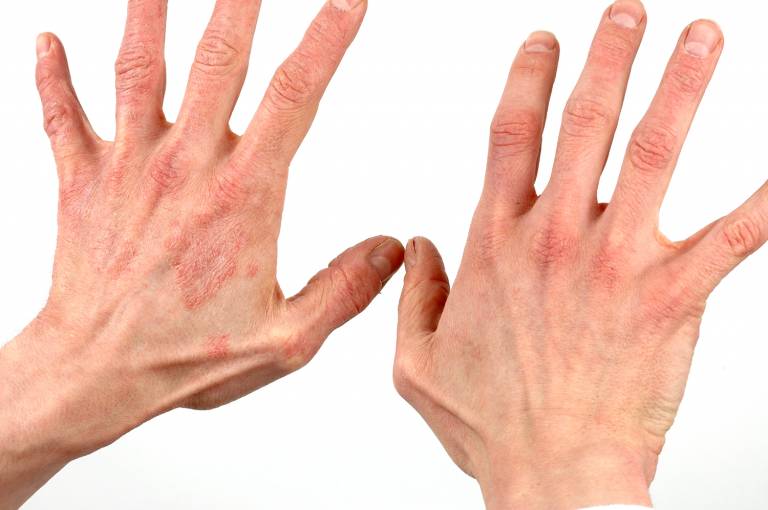Allergens and Sensitisers
This page provides general guidance on allergens and sensitisers in the workplace. Allergens and sensitisers are substances which can cause an allergic reaction in the lungs or skin after exposure.

Image reproduced with permission of Global Skin Atlas
On this page:
- What are allergens and sensitisers?
- Identification of allergens
- Identification of chemical sensitisers
- Symptoms
- Risk assessment
- Guidance on control measures
- Health surveillance
What are allergens and sensitisers?
‘Allergen’ is often used in the context of animals and food; ‘sensitiser’ is often used to refer to chemical substances. Allergens and sensitisers can cause an allergic reaction in the lungs or skin.
An allergic reaction is an immune response to an innocuous substance. Reactions range in severity, from itchy skin to life-threatening conditions such as anaphylaxis. It is crucial to understand what substances may cause an allergic reaction in the workplace, what the symptoms can be and to ensure that activities are risk assessed to prevent harm. Completing a suitable and sufficient risk assessment where people may be exposed to allergens or sensitisers in the workplace is a legal requirement.
Identification of allergens
A dedicated webpage is available for guidance on animal allergens. Guidance from the NHS provides accessible information on food allergy.
Identification of chemical sensitisers
You can identify sensitisers from the hazard statements displayed on pre-packaged chemicals. Look on product labels and on safety data sheets. Relevant statements to look for are:
- H334 - May cause allergy or asthma symptoms or breathing difficulties if inhaled.
- H317 - May cause an allergic skin reaction.
If a substance with either statement above is used in your work, the potential for allergic reaction and the health impact of long-term exposure must be highlighted in your local risk assessments.
The Health and Safety Executive (HSE) has published lists of sensitisers on their website:
> Substances that can cause occupational asthma
> List of skin irritants and sensitisers
Common sensitisers used at UCL that can cause allergic reactions include; Glutaraldehyde, latex, rosin-based solder flux; alcohols, degreasers and epoxy resins.
Symptoms
If exposed to allergens or sensitisers, people can experience acute reactions (immediate onset of symptoms) which subside in a short period of time and may not return. Others may experience chronic reactions, whereby symptoms are experienced repeatedly over a longer period of time.
Symptoms of an allergic reaction include:
- Wheezing or coughing
- Chest tightness and shortness of breath
- Sneezing / a runny nose
- Itchy and inflamed, red eyes
The most common symptom of skin sensitisation is inflammation, known as dermatitis or eczema. It is characterised by redness and heat, swelling, blistering and itchiness. Skin reactions are most often experienced on the hands, forearms and face.
Symptoms can develop immediately after exposure. Sometimes they can appear several hours after exposure, possibly at night. In the early stages, symptoms will improve when away from the affected workplace over weekends or when on annual leave. Over time, individuals can develop severe reactions through repeated exposure, even in small amounts. In some extreme cases, individuals may develop occupational asthma and/or dermatitis, which is inflammation of the skin.
If you experience allergy symptoms that you think are work-related, discuss these with your line manager as soon as possible. They can arrange for referral to Workplace Health.
To support people experiencing allergic reactions, please refer to our guidance on first aid.
Risk assessment
To prevent harm, Principal Investigators (PIs), supervisors or line managers must:
- Plan and control work with hazardous substances, including allergens and sensitisers.
- This includes documenting the hazards and control measures in a risk assessment.
- Risk assessments must be approved before work begins.
- Risk assessments must be reviewed on a regular basis to reflect any changes in activity.
> Further guidance on risk assessment.
Guidance on control measures
Control of exposure must follow the hierarchy of control:
- Eliminate - do you need to use the substance or carry out the activity?
- Substitute – can a safer alternative or a smaller amount be used?
- Engineering controls – can you separate people from the hazard, such as with Local Exhaust Ventilation (LEV), including fume cupboards and safety cabinets?
- Follow a safe system of work – define procedures and communicate controls; ensure people are trained, competent and supervised where needed.
- Use Personal Protective Equipment (PPE) - this may include face masks and gloves, but must be the last resort. PPE must only be used in combination with other control measures.
Exposure should be controlled at source wherever possible, for example using a sensitiser within a fume cupboard to extract the substance from an individual’s breathing zone.
Health surveillance
If allergens or sensitisers cannot be controlled sufficiently by engineering measures; or if there is a reliance on PPE for control, it is likely that health surveillance of individuals will be required. This consists of periodic health checks, through attendance at clinics or completing a questionnaire.
At UCL, health surveillance is managed by Workplace Health.
Last updated: Monday, July 27, 2020
 Close
Close


